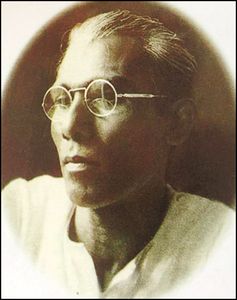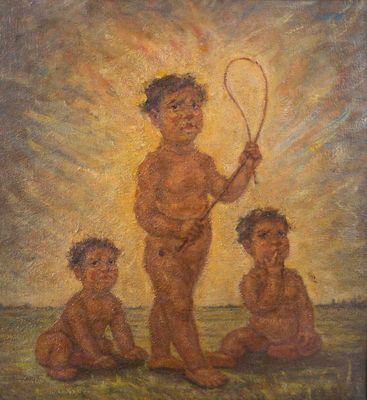A new exhibition in Kolkata offers a retrospective of the pioneer Indian modernist artist Gobardhan Ash, offering a glimpse into four decades of his work from 1929 to 1969. Curated by Brijeshwari Kumari Gohil and Harsharan Bakshi, the exhibition showcases more than 100 artworks, featuring Ash’s diverse creative range, including sketches, landscapes, self-portraits, portraits, rural Bengal scenes, the iconic Avatar Series from the late 1940s, vibrant pastels from his outdoor studies, and his poignant Children Series, capturing the myriad moods of children.
“Our approach was twofold: to underscore Ash’s dedication to each phase and to illuminate the thematic evolution evident in his oeuvre,” said Bakshi. “As such, the exhibition primarily adopts a thematic approach, celebrating Ash’s enduring commitment across various periods of artistic exploration.”
In a year-long research on Ash and his body of work, the curators uncovered the remarkable diversity within each decade, reflecting distinct creative phases in his artistic journey. “Our aim has been to highlight each of his themes, styles and experimentations during these four decades,” explained Gohil. “These span from his time being part of and forming various groups and movements. It is a diverse portfolio, ranging from social realism to creative expressionism and experimentation.”
Rural Bengal is one of the main themes of Ash’s landscape paintings. His famine works in shades of dark and pale brown were painted in different phases in 1943. A skilful portrait artist, he depicted human faces in both line and colour. His Children Series―a collection of 16 oil paintings and 45 sketches painted in oil between 1957 and 1967―stemmed from his fondness for children. His avant-garde Avatar Series, exhibited at the Joint Show of the Calcutta Group and the Progressive Artists’ Group in 1950, inspired experimentation and dialogue.
“The retrospective consists of a world with many worlds, containing philosophies, political beliefs, social realities and visions of an idyllic society,” commented producer, publicist and curator Ina Puri. “It focuses critical attention on one of the most remarkable Bengal modernists of the last millennium, who spent his lifetime restlessly exploring different genres, never content to rest on his laurels for long.”
Born in 1907 in Begampur, West Bengal, Ash hailed from a simple family, living with his parents, three sisters and three brothers. Since childhood, he had a penchant for painting. In 1926, he joined the Government Art School in Calcutta, where he met Jamini Roy for the first time in 1929. Though he left the art school the following year, Ash’s creative life was shaped more by his experiences and relationships than by academic credentials. In his early years, Ash was defiant of the then-British way of teaching art. “Ash forged his own path and did not accept the British academic way of teaching art,” said Gohil. “He was also soaking in what he was witnessing around him during this time period, an important chapter in Indian history as a whole.”
Further, Ash embraced social realism, which is evident in works like Village Girl of Bengal, depicting rural life's realities with the utmost sensitivity. “Ash’s introspective self-portraits, empathetic social realism works, and versatile depictions of old Kolkata, rural Bengal, and animals exemplify his keen observation and artistic versatility,” said Bakshi.
In 1931, he trained at the Madras School of Art under the mentorship of painter and sculptor Devi Prasad Roy Chowdhury. The same year, he played a pivotal role in founding the Young Artists’ Union.
“While Ash considered Atul Bose to be his mentor, the prolific art practitioner had occasions to work alongside some of the most distinguished practitioners of his times when he started The Art Rebel Centre in 1933 with the purpose of making art that was fearless, anti-sentimental and bold; and later, when he joined The Calcutta Group, with Gopal Ghose, Nirode Mazumdar, Abani Sen, Zainul Abedin and Ramkinker Baij among others,” informed Puri. Though short lived, the Art Rebel Centre served its purpose, giving rise to several other larger factions and groups by the 1940s and paving the way for Ash’s artistic mastery to come forward, added Gohil.
“Alongside his peers, he drew inspiration from the common man, a labourer, a farmer toiling in the fields or stable hands, later moving to the turbulent time of the Bengal famine, painting powerful compositions of the starving multitudes thronging the city’s streets begging for a little bowl of rice water,” elaborated Puri. “Apart from these searing works are beautiful portraits of the family, self and spiritual leaders like Sarada Maa and Ramakrishna Paramahansa.”
Throughout his journey, Ash delved into self-portraits, showcasing his evolving artistic identity and mastery of techniques like cross-hatching. “There is a level of intricacy and depth in Ash’s self-portraits where he journals his own identity and its development,” said Gohil. “Given how frequently he dwelled into making self-portraits, it is almost as if he is also exploring different artistic styles of communicating, reflecting and building a visual diary for himself.”
Beyond his artistic contributions, the comprehensive showcase also highlights Ash’s enduring legacy as a mentor and influencer within the Indian art community. “As a dedicated teacher, he established the Fine Art Mission Free Art School in Begumpur in 1956, driven by a profound desire to impart his creative knowledge to future generations of artists,” said Bakshi. “He generously provided art supplies to his students, fostering a nurturing environment for artistic growth.”
In the realm of art history, Ash stands out as a figure of profound significance, and this exhibition bears testimony to this. “Ash embraced his love for his surroundings,” said Gohil. “Several of these human and natural observations not only depict his love for nature and human life, but they are also a way of expressing the human predicament, the struggles. He is journaling his surroundings with these works, but creating statements in the process. There is a strong sense of spirituality to these emotive works.”
‘The Prinseps Exhibition: Gobardhan Ash RETROSPECTIVE’ will continue till April 21 at the Kolkata Centre for Creativity.




